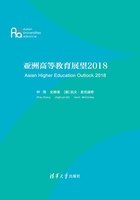
Summary of the Key Information and Messages in the Chapters
Chapter 1 Key Trends Shaping Asian Higher Education
This chapter sets the scene with eight key trends that illustrate the dynamic and diverse socioeconomic and higher education contexts of a rising Asia.
Economic dynamism: Most Asian countries have experienced rapid economic growth during certain periods over the past half-century. Asia is the world's fastest growing economic region and the world's largest continental economy. Several Asian countries have either GDPs or per-capita GDPs that are among the highest in the world. Notwithstanding ongoing developmental challenges and economic uncertainties, Asia is forecast to continue to enjoy economic growth over the coming decades.
Demographic transition: Since the 1970s, Asia has experienced a demographic dividend that has helped to drive economic growth through a rising share of working age population. Asia's population is expected to increase by another 680 million from 2016 to 2050. The rapid increase in the number of young people and the need to care for an ageing population place an increasing demand on quality education.
Rapid urbanization: Asia hosts the world's fastest growing cities. The urban population in Asia is growing faster than in any other region and is projected to reach 64% of total population by 2050. Rapid urbanization with rural to urban migration requires smarter urban planning and governance, sustained investment in urban infrastructure and services, and better external efficiency in higher education.
Holistic human development: Asia has steadily improved education, health, and standard of living over the past two decades. The region is facing a triple challenge of sustaining universal primary education, scaling up enrolment in the diversified secondary and higher education sectors, and enhancing the relevance and responsiveness of education to a competitive labor market and changing workplace.
Rising global presence: Many Asian countries have improved their capacity to engage their economies with other countries beyond the Asian region. In doing so, they have gained a significant amount of influence in shaping the process of globalization over the past two decades. Since 1990, according to the Elcano Global Presence Index, several Asian countries, including China, South Korea, Singapore, Malaysia, and Thailand have attained a highly prominent global saliency.
Increasing access: Many Asian countries have adopted strategies to make the transition from elite to mass higher education. In 1995-2015, the percentage increase in tertiary gross enrolment ratio was 36%-47% across China, Republic of Korea, Saudi Arabia, and Singapore, placing them among the world's most rapid in enrolment growth. Many Asian countries are also notable for higher access rates in higher education for women than men as the result of system-wide promotion of girls' access to schooling and policies supporting women's empowerment.
Stronger reputation: An increasing number of Asian universities are either breaking into or moving upward in world university rankings. The Academic Ranking of World Universities (ARWU) placed 15 Asian universities in world's Top 100 and 126 in World Top 500 in 2016. The Times Higher Education (THE) Rankings of the Top 300 Universities 2016 included universities from 21 countries across Asia, including ten AUA members.
Relocating research to Asia: Asia has experienced marked increases in both the quantity and quality of academic research across almost all disciplines. The number of scientific and technical journal articles increased 2.8 times in Asia while the world total increased 1.7 times between 2002 and 2014. Asia spent more than ever on research and development (R&D) in terms of the proportion of GDP expenditure for R&D, employed more researchers, produced more publications, and achieved the largest world share in these three aspects between 1996 and 2014.
These trends delineate the landscape that AUA can further define and refine. These major features have the potential to influence the future of Asian higher education and the role of AUA within it, as well as the potential of Asian higher education to influence broader global trends.